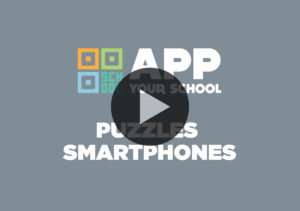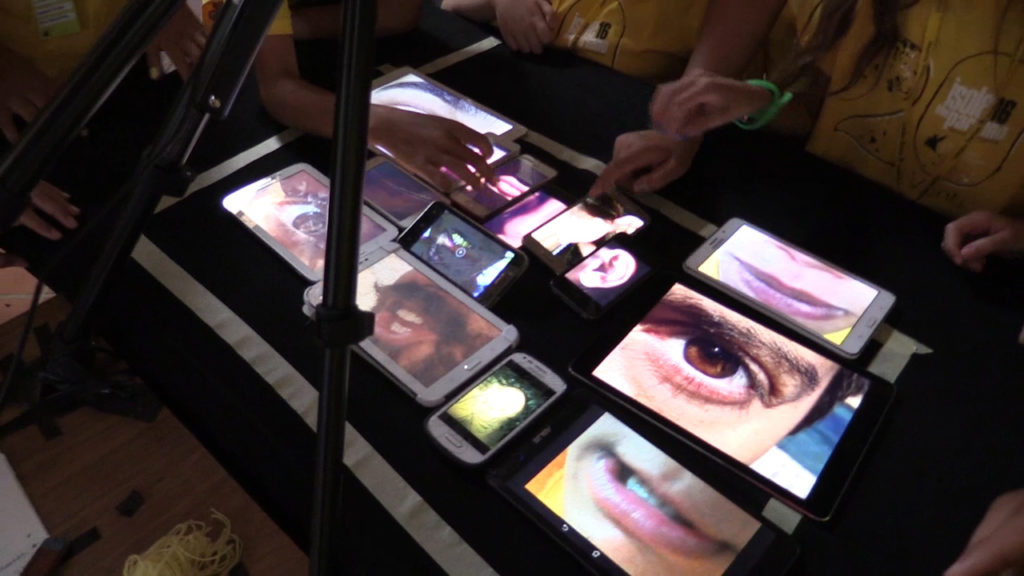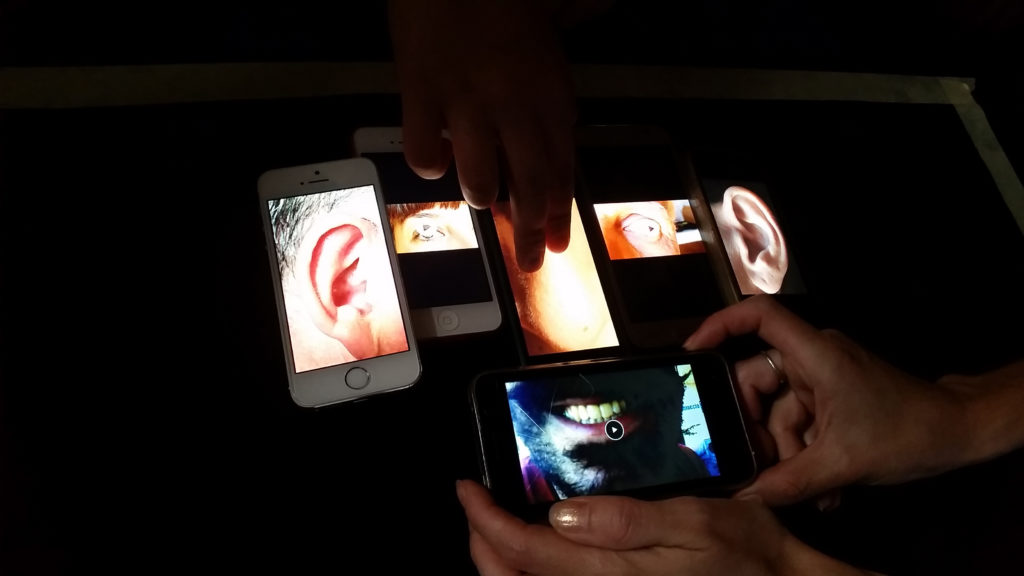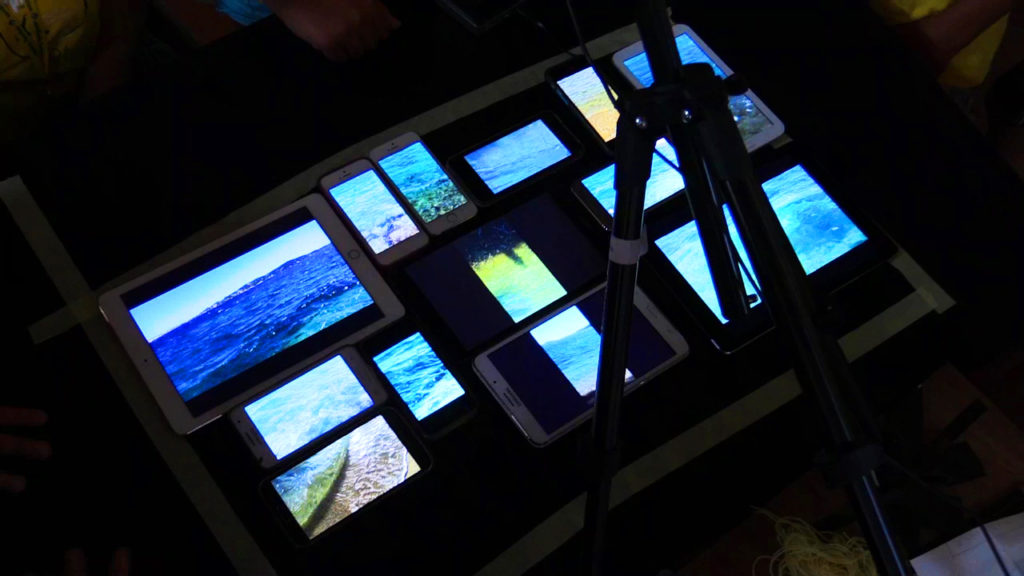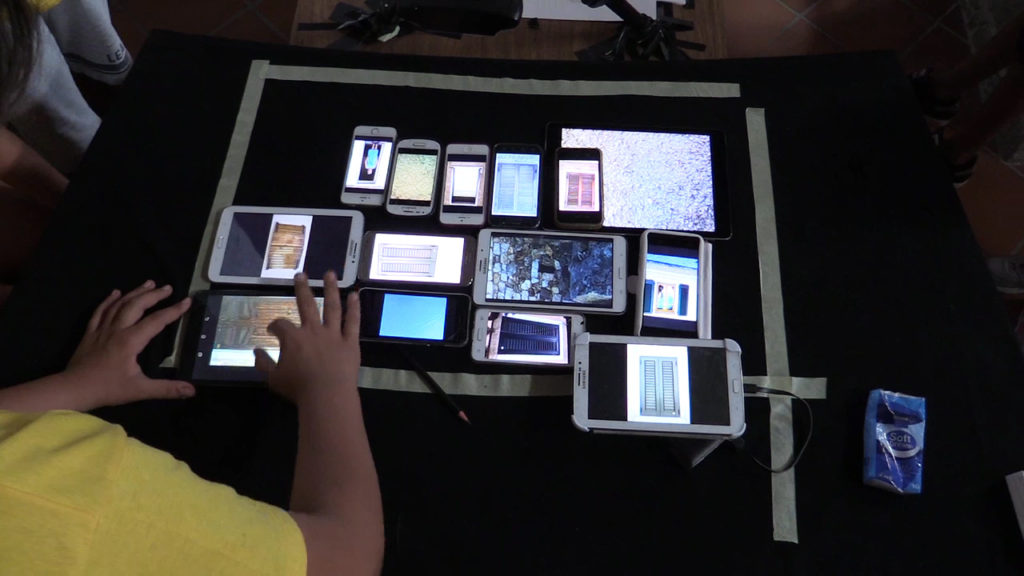Interview to Vinz Beschi (AVISCO – Audiovisivo Scolastico /School Audiovision)
GENERAL SETTING
- 1 – How was this project born: from which needs? To answer which question?
The use of the smartphone conditions the life style of children and adults.
“The mobile phone is the most intimate of our communication technologies, also if some would say also the loudest and most intrusive” (Derrik de Kerckove).
Just look at the reality around us and see that this is so, the distinguishing feature of this technology and with whom we constantly interface – is the screen. So the project was born from the question: But what is a screen? Over a century the screen – large, small, portable – has become increasingly important in human life. Since the silent film – with characters more or less comic – who were moving on the large canvas, teaching viewers new rhythms of life. Already the first film helped change the habits of lifestyles. Then came the television screen in every home and did the rest. Now even this little screen has been exceeded by an even smaller screen, that almost every person carries in their pocket, thanks to the smartphone. This project focussed in particular on one element: the luminous screen. The screen as : shared active screen ; the use of the screen; as similar in the time of silent film – as an interface that opens to the world
“The screen misleads, the screen captivates. The screen leeds astray, and binds together. In a word, the screen seduces. It carries us away, in fact. Literally. Enough to invite us to live with him.” (quotation from Mauro Carbonne, professor at the University Jean Moulin Lyon 3, from: “Filosofia- schermi” dal cinema alla rivoluzione digitale (Screens – Philosophy. From Cinema to digital revolution) The screen understood as an observation of reality: our participation in events is vividly filtered from the screens. The screen starts as a shared offer – the screen of the smartphone instead is personal. The screen starts as a passive screen – now we have an active screen. We have now everyday and at any time an object to hand that at the same time registers and reproduces immages and sounds – immages today are immediate – tecnology is mobile.
We carry the object “smart phone” in our pockets as we once carried our frippery. (like the frippery “cianfrusaglie” of the Agazzi sisters: they used objects found in the pockets of the children as pedagogical materials) So why not try to put on the table our eletronic “frippery”, and “undress” ourselves showing them to the others.
- 2 – What is in your opinion innovative on this project?
Puzzle Smartphone is a “laboratorio” that AVISCO is testing, where people are invited to attend with their smartphone, purely individual devices that will be put at the disposal of others, to build something together. It is a quite new operation in the use of these tools which will see the participants in the laboratorio capture fragments of images, to find themselves gathered on an horizontal plane, connected in a closed circuit by a projector, on which they will lay down their smart phones, like the pieces of a puzzle , in order to compose a new collective image.
Many are the combinations and methods of forming the puzzle and completely unpredictable and surprising the results. We have not yet had time to be able to experience in the deep this idea, but in these first steps we saw the huge opportunity to follow very different paths. The meeting between the personal screens, which on the “mother” screen try to agree like the instruments of an orchestra, is visual experimentation but also mutual understanding and collective planning. Innovative in this project is: to take a so daily and intimate “tool/ instrument”, that is so essential for the adolescents, so important and to use it in a diverse way. To take this tool that is so private and personal and to use it in a group work to create art – like a shadow theater, as the the shadows of the hands over the “luminous screens “ of the smart phones you see then on the big screen seem to interact as figures in a shadow theater. With animations and the smart phones in “loop the activities create also a different interaction between the various devices, and a “real” non filtered interaction between the teenagers. To work as a group and reflect on the tool itself and on what they are doing – so the intimate in a collective reflection. In the group work it is not important that every adolescent has a smart phone, in order to avoid “discrimination” or a feeling of discrimination from the ones that are “deprived” on a daily basis of this tool. The smart phones become part of a common creative experience.
- 3 – Which are in your opinion the ICT competencies of adolescents that are important for your project? And how are they valorized through your project?
The adolescents are in the most cases very competent with their personal devices – the various functions of the device, applications, what it can and can’t do. But they are very concentrated on one device – their own. The difficulties are more in the management of more screens contemporaneously – my screen as a detail of a collective image. We discuss with the adolescents about the needed competences – it is important to gather suggestions they give you – as they are some times more competent as ourselves and give ideas that you didn’t take into consideration before.
- 4 – What did your discover through the project that you didn’t expect or imagine?
The idea on itself seemed very simple – but that are so may possibilities of use that you can not foresee, as you don’t know all the devices and functionality. It is therefore difficult to give precise rules, the field is so vast that you risk to not obtain a result, a concrete result. So the proposal for the activities and the adolescents has to be very clear and specific in order to develop a common line.
- 5 – What is the link between your project, media competencies and active citizenship?
To make of a private experience a commune one – to transform a relation with a device from consumer to producer, to produce something as a collective work. The work of each participant affects the quality of the final result – so the development of responsibility in a collective project. The experience of the “small” transported in a field of participation – active use of your device in a participatory way, responsibility in the use of a communication device with the conscious use of contents and finding a “together” in this consciousness. The competencies of listening to each other and to mediate – so not to be a simple user but a mediator. Focus on the media competencies as an inclusive factor – for example a girl in a wheelchair was very “mobile” and competent in using various devices at the same time, the activity valorized her different competencies.
EXPERIENCE REPORTING
1 – What happens during activities? Which working steps are asked from the students?
During the activity the participants have the opportunity to create images on a screen created by all the different personal screens placed next to each other or overlapping. Through the hands they will change the pictures using the tipical gestures of the touch screen (Touch, double-tap, scroll, dragging, crawl, pinching, etc …) and by changing the position of the various screens inside the framing.
Predisposing the set, we highlight some of the aspects that will be in many forms the subject to be treated, in particular through the images collected by the participants and the game of relations between them(on / off, approach / move away, decomposition / composition, multiplication, overlapping, etc …).
From the students we required to provide their devices after a preparation of their smartphone – as everything in the screen will be visible, to decide which contents can be viewed and which not.
THE STAGES OF WORK are diversified on the basis of the kind of experience and its duration. phases of work for a laboratory of about 9 hours – (3 x 3-hour modules)
1st block
- wellcome and getting to know each other
- Introduction to the laboratory
- practical testing of how the set of shared active displaysfunctions: using images of a square, a circle, a triangle, which the participants will have photographed before the start of the workshop. (If they were not successful, they will have the opportunity to photograph the three elements at the time).
- Presentation of the theme and directions on what to keep in mind when doing the photo shoots, and possibly even some short video, using smartphones and tablets.
- Planning of the various blocks referring to the various elements inherent to the subject to be photographed. Patterns and shapes of smartphones and tablets will be made available.
- For the design of each sequence it must be indicated:
the content of the individual images to be shown in the screens.
approximately how the complete picture as a result of all the shots should appear the necessary number of smartphones
the way you compose the image
What is to be moved within each smartphone, and if you change position of the smart phone, what are the movements to be made
the way in which the image is to be decomposed and disappears
2nd block
- going out into the field to photograph the various elements vision of images and discussion
3rd block
- Realization of the designed sequences in the set prepared for filming Indicatios for editing.
2 – Which methodologies do you use?
The methodology is based on cooperative learning: the experience in fact is based on the active involvement of participants in a team environment where everyone assumes very specific responsibilities and is constantly compared with the proposals of others. The achievement of the result is based on the interaction among the members of the group and on the continuous evaluation of the various suggestions.
The task of the operator leading the workshop is to develop and foster an environment in which participants can move with the knowledge, that the result depends precisely on their choices and actions. It will ensure that the focus of the group is on the specific delivery and will encourage the participation of all.
- 3 – Which tools?
- Tablet
- smart phone
- notebook
- web cam
- easel
- 1 video camera for backstage
- 1 camera extension cables amplifier
- 4 – Which materials?
Patterns and shapes of smart phone and tablet on card stocks 2 black basis for the set stationary.
- 5 – Which project choices do you consider strategic?
The use of the devices with which children are confronted every day favors for sure the participation and involvement, especially if the activity takes place in a social and educational sphere. The ability to use these tools, to know the territory around them (places, environments, routes, architectures, but above all people) and to represent it creatively on a collective screen is a strategic choice, to make each participant feel involved and responsible for the project.
The “physical” contact and the exchange of what is “your own” is surprisingly successful , also if it can be destabilizing at the beginning. Innovation in this case is in the “medium”, that is usually used as a personal and intimate tool – which by sharing becomes an opportunity to promote creative pathways of socialization.
Also, teenagers are often motivated in using smartphones and tablets also because they are more competent then us adults. For this reason during the experience it is important to grasp their suggestions and see if they can be useful for discovering new paths to be undertaken.
- 6 – What do they learn? Which competences are developed and enhanced?
Participation to the elaboration of a collective work with a personal device; strengthen of coordination capacities; listening to others; mediating; contemporary use of several visual information.
The project asks from the participants a big willingness to get involved and to make your personal object available for a common objective. So it enhances the capacity to work in a group, to coordinate yourself through the individuation of rules through a common agreement and to listen to each other in order to decide which could be the best action in that specific moment.
- 7 – Which are expected results and those effectively attained?
In all cases objectives have been exceeded – as all teenagers after a brief moment of being reluctant in “exposing” their very personal device, are participative, engaged and propose new ways of experiences each one has to loose its own modality of action in a predisposed group start from a common level
screen as a hope of interaction
positive vision of the device
creative use
potential of the devices in fostering creative and active participation, in a community
- 8 – How do you evaluate this experience? Do you evaluate it at all?
There is still no instrument of evaluation.
The experience is still very new, so: Which are the elements to evaluate?
The critical aspects are that the divergent proposals and solutions of the adolescents are so many and different that it is important but difficult to keep a red line. But as all visual artistic productions there is the spectator. At the end of the experience the result is presented to an audience and here you have an evaluation of the “product”, a reaction. A crucial aspect of the audiovisual production is that it is made to be seen and to incite a reaction.
- 9 – When things don’t work out, how do you re-adapt activities?
There were little problems, that were more “functional”, for example the standby function of the smart phone, so the light turns off during registration.
Beyond technical issues we realized that it was important to give more precise guidelines for the activity – as the possibilities are so vast. Whenever something is born unexpectedly, we tried to seize the unexpected to readjust the proposal. So you interact during the activity and “re-adapt”.
